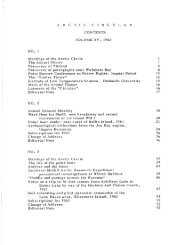Volume 4, 1951 - The Arctic Circle - Home
Volume 4, 1951 - The Arctic Circle - Home
Volume 4, 1951 - The Arctic Circle - Home
Create successful ePaper yourself
Turn your PDF publications into a flip-book with our unique Google optimized e-Paper software.
Two lines of soundings were taken and plotted in<br />
Gray Strait, which was now free of ice. This vvork had to<br />
be done at night and the staff was put into eontinuous watches.<br />
<strong>The</strong> course lay to the westvlJardof the Button Islands to Acadie<br />
Cove, Resolution Island, which we entered at 0600 on July 22.<br />
Radio problems were discussed with the Department of Transport<br />
radio operators there, before continuing into Gabriel Strait<br />
that afternoon. Some very large icebergs and numerous small<br />
bergs and growlers were sighted in the strait, and the vessel<br />
sailed through moderately heavy broken pan ice.<br />
Frobisher Bay was entered in the early hours of<br />
July 23, and the passage of the bay became increasingly difficult<br />
because of heavy ice. Following small leads of open<br />
water the vessel was forced over to the east shore, eventually<br />
reaching a small anchorage between the northern end of Gabriel<br />
Island and a small islet lying off that island. Here she was<br />
securely hemmed in by almost unbroken ice to the north. AS<br />
these waters were completely unchart3à. extreme caution had<br />
to be used at all times.<br />
<strong>The</strong> Algerine remained at anchor at Gabriel Island<br />
for two days, until from a height of land behind the harbour<br />
a few leads were seen opening up along the western shore.<br />
With considerable difficulty, and after running northwards<br />
on the east side of Chase Island as far as Field Island, the<br />
vessel managed to reach the western shore in the vicinity of<br />
Mt. President's Seat. <strong>The</strong> iee and adverse winds once more<br />
made it necessary ta find shelter, and the ship anchored in<br />
Robinsons Harbour, north of Wynne-Edwards Bay, at 1800 on<br />
July 29. <strong>The</strong> following day, one launch was put in the water<br />
and as many soundings were taken as the close-packed ice would<br />
allow in this small anchorage. A party climbed a 2,000-foot<br />
peak and sighted what appeared to be slightly better conditions<br />
up the baYe But the next day the vvind was strong and unfavourable<br />
and it was not until 1600 on August 2 that the vessel could<br />
proceed. Meanwhile the winds had shifted the ice, and it was<br />
possible to follow some leads up the western side of the bay,<br />
breaking through heavy ice at times. At 0530 on August 3 the<br />
ship was caught in heavy ice in the entrance to Bartlett Narrows,<br />
and carried through the narrow strait, three cables wide, in a<br />
solid ice jam by the tide, running at approximately five knots.<br />
Captain Hancock managed to get the ship's head around to the<br />
westward, so that she was carried through beam-on, and by going<br />
full ahead before Sh8 had actually reached the northern end of<br />
the Narrows, she just cleared the dangerous Charybdis Reet.<br />
<strong>The</strong> remaining 25-mile run to Koojesse Inlet was completed<br />
without difficulty through comparatively ice-free water.<br />
During the entire passage from Burwell to Koojesse Inlet continuous<br />
soundings were taken and plotted, fixing being done by<br />
tangents to points of land.












